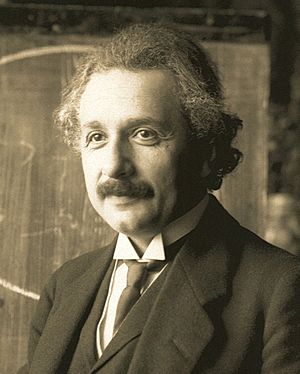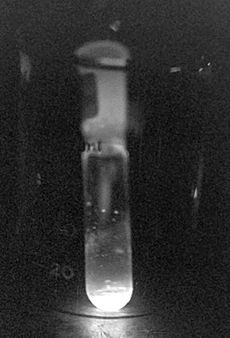Einsteinium facts for kids

Einsteinium is a chemical element with the atomic number 99. That means an Einsteinium atom has 99 protons and 99 electrons. It is a synthetic element, so all isotopes are radioactive.
Einsteinium is named after Albert Einstein. It was found for the first time in 1952 by Albert Ghiorso and his team of scientists in the debris of the first hydrogen bomb explosion, and identified as an element at the University of California, Berkeley.
Einsteinium belongs to the actinoids, and it is the 7th of them. The most stable isotope of Einsteinium has 99 protons and electrons and 153 neutrons. There are 19 different (radioactive) isotopes.
Einsteinium isotopes have a half-life between 40 and 471 days. Einsteinium has been used to create the element Mendelevium for the first time, in 1955, although no practical uses are known.
Contents
Characteristics
Physical
Einsteinium is a synthetic, silver, radioactive metal. In the periodic table, it is located to the right of the actinide californium, to the left of the actinide fermium and below the lanthanide holmium with which it shares many similarities in physical and chemical properties. Its density of 8.84 g/cm3 is lower than that of californium (15.1 g/cm3) and is nearly the same as that of holmium (8.79 g/cm3), despite atomic einsteinium being much heavier than holmium. The melting point of einsteinium (860 °C) is also relatively low – below californium (900 °C), fermium (1527 °C) and holmium (1461 °C). Einsteinium is a soft metal, with the bulk modulus of only 15 GPa, which value is one of the lowest among non-alkali metals.
Contrary to the lighter actinides californium, berkelium, curium and americium, which crystallize in a double hexagonal structure at ambient conditions, einsteinium is believed to have a face-centered cubic (fcc) symmetry with the space group Fm3m and the lattice constant a = 575 pm. However, there is a report of room-temperature hexagonal einsteinium metal with a = 398 pm and c = 650 pm, which converted to the fcc phase upon heating to 300 °C.
The self-damage induced by the radioactivity of einsteinium is so strong that it rapidly destroys the crystal lattice, and the energy release during this process, 1000 watts per gram of 253Es, induces a visible glow. These processes may contribute to the relatively low density and melting point of einsteinium. Further, owing to the small size of the available samples, the melting point of einsteinium was often deduced by observing the sample being heated inside an electron microscope. Thus, the surface effects in small samples could reduce the melting point value.
The metal is trivalent and has a noticeably high volatility. In order to reduce the self-radiation damage, most measurements of solid einsteinium and its compounds are performed right after thermal annealing. Also, some compounds are studied under the atmosphere of the reductant gas, for example H2O+HCl for EsOCl so that the sample is partly regrown during its decomposition.
Apart from the self-destruction of solid einsteinium and its compounds, other intrinsic difficulties in studying this element include scarcity – the most common 253Es isotope is available only once or twice a year in sub-milligram amounts – and self-contamination due to rapid conversion of einsteinium to berkelium and then to californium at a rate of about 3.3% per day.
Thus, most einsteinium samples are contaminated, and their intrinsic properties are often deduced by extrapolating back experimental data accumulated over time. Other experimental techniques to circumvent the contamination problem include selective optical excitation of einsteinium ions by a tunable laser, such as in studying its luminescence properties.
Magnetic properties have been studied for einsteinium metal, its oxide and fluoride. All three materials showed Curie–Weiss paramagnetic behavior from liquid helium to room temperature. The effective magnetic moments were deduced as 10.4±0.3 μB for Es2O3 and 11.4±0.3 μB for the EsF3, which are the highest values among actinides, and the corresponding Curie temperatures are 53 and 37 K.
Chemical
Like all actinides, einsteinium is rather reactive. Its trivalent oxidation state is most stable in solids and aqueous solution where it induces a pale pink color. The existence of divalent einsteinium is firmly established, especially in the solid phase; such +2 state is not observed in many other actinides, including protactinium, uranium, neptunium, plutonium, curium and berkelium. Einsteinium(II) compounds can be obtained, for example, by reducing einsteinium(III) with samarium(II) chloride. The oxidation state +4 was postulated from vapor studies and is as yet uncertain.
Isotopes
Nineteen isotopes and three nuclear isomers are known for einsteinium, with mass numbers ranging from 240 to 257. All are radioactive and the most stable nuclide, 252Es, has a half-life of 471.7 days. The next most stable isotopes are 254Es (half-life 275.7 days), 255Es (39.8 days), and 253Es (20.47 days). All of the remaining isotopes have half-lives shorter than 40 hours, most shorter than 30 minutes.
Nuclear fission
Einsteinium has a high rate of nuclear fission that results in a low critical mass for a sustained nuclear chain reaction. This mass is 9.89 kilograms for a bare sphere of 254Es isotope, and can be lowered to 2.9 kilograms by adding a 30-centimeter-thick steel neutron reflector, or even to 2.26 kilograms with a 20-cm-thick reflector made of water. However, even this small critical mass greatly exceeds the total amount of einsteinium isolated thus far.
Natural occurrence
Because of the short half-life of all isotopes of einsteinium, any primordial einsteinium—that is, einsteinium that could have been present on the Earth at its formation—has long since decayed. Synthesis of einsteinium from naturally-occurring actinides uranium and thorium in the Earth's crust requires multiple neutron capture, which is an extremely unlikely event. Therefore, all terrestrial einsteinium is produced in scientific laboratories, high-power nuclear reactors, or in nuclear weapons tests, and exists only within a few years from the time of the synthesis.
The transuranic elements from americium to fermium, including einsteinium, were once created in the natural nuclear fission reactor at Oklo, but no longer.
Einsteinium was theoretically observed in the spectrum of Przybylski's Star. However, the lead author of the studies finding einsteinium and other short-lived actinides in Przybylski's Star, Vera F. Gopka, admitted that "the position of lines of the radioactive elements under search were simply visualized in synthetic spectrum as vertical markers because there are not any atomic data for these lines except for their wavelengths (Sansonetti et al. 2004), enabling one to calculate their profiles with more or less real intensities." The signature spectra of einsteinium's isotopes have since been comprehensively analyzed experimentally (in 2021), though there is no published research confirming whether the theorized einsteinium signatures proposed to be found in the star's spectrum match the lab-determined results.
| Periodic table | |||||||||||||||||||||||||||||||||||||||||
|---|---|---|---|---|---|---|---|---|---|---|---|---|---|---|---|---|---|---|---|---|---|---|---|---|---|---|---|---|---|---|---|---|---|---|---|---|---|---|---|---|---|
| H | He | ||||||||||||||||||||||||||||||||||||||||
| Li | Be | B | C | N | O | F | Ne | ||||||||||||||||||||||||||||||||||
| Na | Mg | Al | Si | P | S | Cl | Ar | ||||||||||||||||||||||||||||||||||
| K | Ca | Sc | Ti | V | Cr | Mn | Fe | Co | Ni | Cu | Zn | Ga | Ge | As | Se | Br | Kr | ||||||||||||||||||||||||
| Rb | Sr | Y | Zr | Nb | Mo | Tc | Ru | Rh | Pd | Ag | Cd | In | Sn | Sb | Te | I | Xe | ||||||||||||||||||||||||
| Cs | Ba | La | Ce | Pr | Nd | Pm | Sm | Eu | Gd | Tb | Dy | Ho | Er | Tm | Yb | Lu | Hf | Ta | W | Re | Os | Ir | Pt | Au | Hg | Tl | Pb | Bi | Po | At | Rn | ||||||||||
| Fr | Ra | Ac | Th | Pa | U | Np | Pu | Am | Cm | Bk | Cf | Es | Fm | Md | No | Lr | Rf | Db | Sg | Bh | Hs | Mt | Ds | Rg | Cn | Uut | Fl | Uup | Lv | Uus | Uuo | ||||||||||
|
|||||||||||||||||||||||||||||||||||||||||
Images for kids
-
The element was discovered by a team headed by Albert Ghiorso.
See also
 In Spanish: Einstenio para niños
In Spanish: Einstenio para niños








